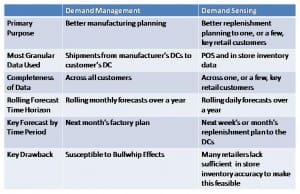I believe that one of the emerging trends that will differentiate leaders from followers in the consumer goods industries is that leaders will excel at integrating their demand management and replenishment processes with category management. Consequently, it benefits supply chain executives to better understand leading practices in category management.
Supply Chain Digest recently aired a videocast featuring Dave Boissevain, Director of Retail Strategy and Planning at Frito-Lay, which laid out at least one leading practice: the use of store-level planograms.
A planogram (POG) is a diagram of fixtures (e.g., shelves) and products that illustrates how and where retail products should be placed in a store. Leading retailers have moved to having category captains produce POGs that are communicated and explained to the retailer for all the goods in a category (like salty snacks in the case of Frito-Lay).
It is the category captain’s job to maximize the profitability of the retailer’s shelf. Think of this as the velocity at which store profits are created based on product margin, supply chain costs, and how goods flow off the shelf. This is sometimes called “return-on-shelf.”
In putting together a planogram, the category captain needs to use syndicated data and point of sale (POS) data to understand trends.
They also need to understand product affinities to better allocate shelf real estate to profitable stock keeping units (SKUs). Frito-Lay conducted a study where it went into certain stores and eliminated 10 percent of the salty snack SKUs. The company then eliminated 20%, 30%, and 40% of the SKUs in that category. It did this to better understand the incrementality of the item. If an item was removed, how would it affect the sales of other SKUs in the store? The interesting thing that Frito-Lay discovered is that for large format stores customers actually liked the layout better when the SKUs were reduced by 20 or 30 percent.
Historically, planograms were “one-size-fits-all” that applied to every store in a chain of a similar size. So, all stores with 20-ft aisles used one POG, all stores with 100-ft aisles used another, and so on.
Eight to ten years ago the state of the art improved. Category captains began to do demand-based clustering. So, if a chain had 100 stores, they might have 7 different demand clusters. Planograms would then be created based on the demographics of that cluster and the size of the aisle. Thus, a category captain could end up creating 49 different POGs if the chain had different size stores in all clusters. Because a category captain was more than likely to be a category captain at other (often larger) chains, the creation of these POGs was labor intensive.
Now, the next leap has been made: the ability to dynamically create store-specific POGs based on an optimization engine. This engine produces POGs in 3 seconds versus the 30 minutes it used to take. Consequently, not only can you do store-specific POGs, you can now do them more frequently, maybe every month instead of annually. Frito-Lay is using a new product from JDA Software (an ARC client) for this purpose.
When Frito-Lay moved from POGs developed for store clusters to store-specific POGs, it improved growth by 2 to 4 percentage points! What Frito-Lay found was that the assortment, based on the POG, might be fine Monday through Thursday, but a store-level POG really drove growth in peak selling times, Friday through Sunday. Thus, moving to store-level planograms creates more demand. This forward plan for increased demand needs to be integrated into the supply chain planning and replenishment processes.
To get retailers to agree to this, Dave said that they need to be educated on how the black box optimization engine works. Retailers, after all, ultimately make the final decision on assortment. Moving to monthly POGs also creates more work for retailers. Finally, better planning has limited value unless the plans are fully executed. Frito-Lay is experimenting with a solution from ShelfSnap to help improve execution.
However, Dave said that once retailers try this, they don’t go back!





















